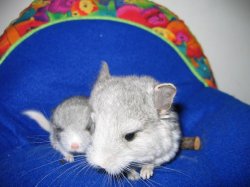I know i didnt explain it very good but another member of the rescue found this following bit that explains it better sorry for anyone not interested but its long
this is an intersting read ;
Superfoetation does not occur at all in some animals but does in others; of the former some are able to bring the later formed embryo to birth, while others can only do so sometimes. The reason why it does not occur in some is that they produce only one young one, for it is not found in solid-hoofed animals and those larger than these, as owing to their size the secretion of the female is all used up for the one embryo. For all these have large bodies, and when an animal is large its foetus is large in proportion, e.g. the foetus of the elephant is as big as a calf. But superfoetation occurs in those which produce many young because the production of more than one at a birth is itself a sort of superfoetation, one being added to another. Of these all that are large, as man, bring to birth the later embryo, if the second impregnation takes place soon after the first, for such an event has been observed before now. The reason is that given above, for even in a single act of intercourse the semen discharged is more than enough for one embryo, and this being divided causes more than one child to be born, the one of which is later than the other. But when the embryo has already grown to some size and it so happens that copulation occurs again, superfoetation sometimes takes place, but rarely, since the uterus generally closes in women during the period of gestation. If this ever happens (for this also has occurred) the mother cannot bring the second embryo to perfection, but it is cast out in a state like what are called abortions. For just as, in those animals that bear only one, all the secretion of the female is converted to the first formed embryo because of its size, so it is here also; the only difference is that in the former case this happens at once, in the latter when the foetus has attained to some size, for then they are in the same state as those that bear only one. In like manner, since man naturally would produce many young, and since the size of the uterus and the quantity of the female secretion are both greater than is necessary for one embryo, only not so much so as to bring to birth a second, therefore women and mares are the only animals which admit the male during gestation, the former for the reason stated, and mares both because of the barrenness of their nature and because their uterus is of superfluous size, too large for one but too small to allow a second embryo to be brought to perfection by superfoetation. And the mare is naturally inclined to sexual intercourse because she is in the same case as the barren among women; these latter are barren because they have no monthly discharge (which corresponds to the act of intercourse in males) and mares have exceedingly little. And in all the vivipara the barren females are so inclined, because they resemble the males when the semen has collected in the testes but is not being got rid of. For the discharge of the catamenia is in females a sort of emission of semen, they being unconcocted semen as has been said before. Hence it is that those women also who are incontinent in regard to such intercourse cease from their passion for it when they have borne many children, for, the seminal secretion being then drained off, they no longer desire this intercourse. And among birds the hens are less disposed that way than the cocks, because the uterus of the hen-bird is up near the hypozoma; but with the cock-birds it is the other way, for their testes are drawn up within them, so that, if any kind of such birds has much semen naturally, it is always in need of this intercourse. In females then it encourages copulation to have the uterus low down, but in males to have the testes drawn up.
It has been now stated why superfoetation is not found in some animals at all, why it is found in others which sometimes bring the later embryos to birth and sometimes not, and why some such animals are inclined to sexual intercourse while others are not.
Some of those animals in which superfoetation occurs can bring the embryos to birth even if a long time elapses between the two impregnations, if their kind is spermatic, if their body is not of a large size, and if they bear many young. For because they bear many their uterus is spacious, because they are spermatic the generative discharge is copious, and because the body is not large but the discharge is excessive and in greater measure than is required for the nourishment wanted for the embryo, therefore they can not only form animals but also bring them to birth later on. Further, the uterus in such animals does not close up during gestation because there is a quantity of the residual discharge left over. This has happened before now even in women, for in some of them the discharge continues during all the time of pregnancy. In women, however, this is contrary to Nature, so that the embryo suffers, but in such animals it is according to Nature, for their body is so formed from the beginning, as with hares. For superfoetation occurs in these animals, since they are not large and they bear many young (for they have many toes and the many-toed animals bear many), and they are spermatic. This is shown by their hairiness, for the quantity of their hair is excessive, these animals alone having hair under the feet and within the jaws. Now hairiness is a sign of abundance of residual matter, wherefore among men also the hairy are given to sexual intercourse and have much semen rather than the smooth. In the hare it often happens that some of the embryos are imperfect while others of its young are produced perfect.





 Stop it with the cutness. I am going to pass out. They are so GORGEOUS!!!! Congrats, again, on the baby. And wow, she is a miracle mom. Didn't you say she was in really bad shape when you got her, and now after a month she's given you two beautiful babies.
Stop it with the cutness. I am going to pass out. They are so GORGEOUS!!!! Congrats, again, on the baby. And wow, she is a miracle mom. Didn't you say she was in really bad shape when you got her, and now after a month she's given you two beautiful babies. 

 Omg, overload of cuteness factor please stop! Chin babies are too friggin cute its unbelieveable.
Omg, overload of cuteness factor please stop! Chin babies are too friggin cute its unbelieveable. 